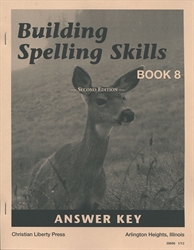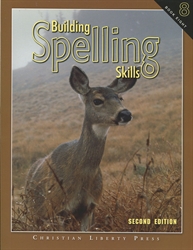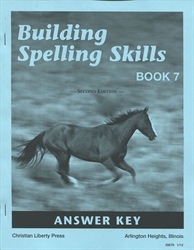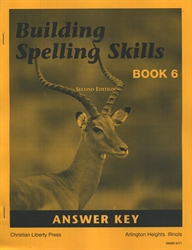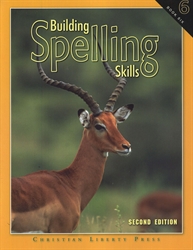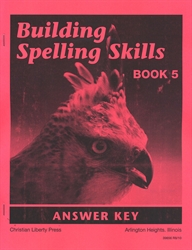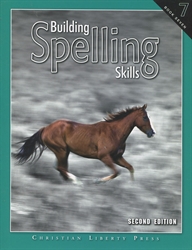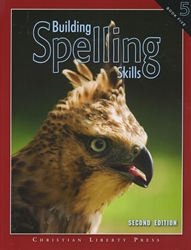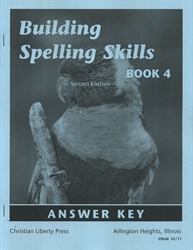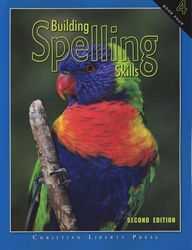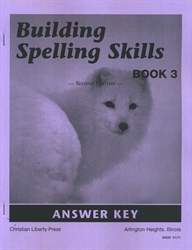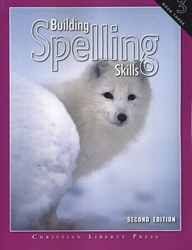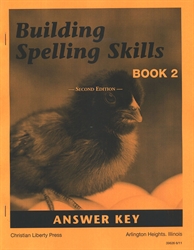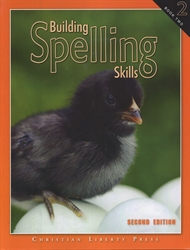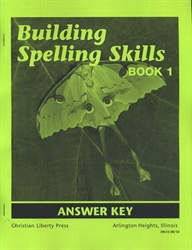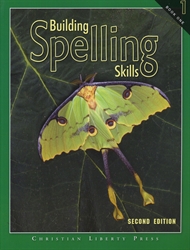It doesn’t get any more affordable for solid spelling coverage than the Building Spelling Skills series. However, you can’t describe these books as “fun” or “colorful.” Instead, I would use words like “comprehensive,” “thorough,” and “challenging.” Illustrations are mostly clip art, and books are printed in two colors.
Each worktext is divided into thirty-six units with five lessons per unit; this corresponds to a basic thirty-six week school year with one lesson per day. Space for students to take their weekly unit tests is provided at the back of each book.
Courses begin in the early grades with a strong basis in phonics, shifting toward word origins and language principles in upper grades. The level of difficulty is higher than in most other series and even more so at upper levels. Also, there is Christian content throughout.
Each book is a self-contained, consumable student worktext. Students should be able to work independently through these books for the most part, especially past the early grades. Inexpensive answer keys are available for all books. There are no separate teacher guides. These last features coupled with cost effectiveness make these books very appealing for busy families with limited budgets.
Book 1
This first grade workbook serves as much for phonics reinforcement as it does for spelling. All but the last two units are designed around a phonics rule. (The last two units work on syllables.) The first five units cover the short vowels, working only on words with the designated short vowel sound. Almost all of the phonograms are covered in Book 1.
The variety of exercises within the lessons induces the child to practice writing words over and over. The number of words per lesson seems a little large in comparison to other programs, and the difficulty level also is advanced. Examples of the more difficult words are voyage, poison, grudge, because, awkward, and laundry.
Space for children to take their weekly tests is provided at the back of the book. Teaching instructions are at the front. Some content and inserted verses and quotations identify the curriculum as Christian.
Book 2
Book 2 accelerates the emphasis on phonics rules with some intense phonics vocabulary. Weekly word lists are introduced with definitions of phonetic concepts (such as consonant digraphs) or rules of syllabication. Some of the lessons deal with root words, prefixes, and suffixes, and words with the digraphs "ch, sh, th," and "wh." There is plenty of practice in Book 2, but as in Book 1 the word lists are generally more advanced than in other second grade programs. Examples of the more difficult words: adage, foreign, cyclone, musician, disappear, although, exodus, and accomplish.
Book 3
This book seems to build on Book 2, assuming that much of the phonetic vocabulary is familiar. Among lesson topics are consonant blends, consonant digraphs, hard and soft sounds of “c” and “g,” vowel digraphs, and diphthongs. Phonics “Rules and Definitions” appear at the back of the book for reference. Like Book 2, it is very rule-oriented, reviewing previously-covered phonetic rules, then moving on to still more rules. The difficulty level still seems advanced with words such as audience, dynamite, and luncheon, but not quite as much so as the first two books.
Book 4
Book 4 continues in the same vein but moves on to accents, more complicated prefix and suffix work, contractions, possessives, compound words, and calendar and measurement words. Lessons also cover consonant digraphs, plural words, and irregular spellings. In addition, often challenging word endings are included, such as “el, le, al, ol, er, or, ent, ant, ible,” and “able." Another interesting feature is a lesson on computer-related terms, updated in 2011.
Book 5
Book 5 is subtitled The World of Words. The first eight units deal with geography-related words, and the ninth unit deals with astronomical terms. Remaining units feature individual topics such as birds, sports, anatomy, economics, and terms related to church. Exercises are very eclectic rather than following similar formats each time. One might have students practice with antonyms or suffixes, while others concentrate on the unit topic with vocabulary and practical usage. There is a great deal of practical and academic usage in this book. For example, in Unit 2 students learn the names given to citizens in various countries (e.g., the Danish live in Denmark). In another example from Unit 19 on “Titles for Civil Officers,” students learn job descriptions for mayor, notary, auditor, magistrate, constable, assessor, etc. Book 5 strikes me as one that might be used whenever this type of study seems appropriate for a student rather than at a particular grade level.
Book 6
Book 6 differs from the other books in this series since it reviews the basic spelling rules students should have encountered in the early elementary years. This is a good time to review because most students have forgotten there are patterns to help them figure out the spelling of unfamiliar words even if they use that knowledge without realizing it.
Review does not take students back to one-syllable words but introduces challenging words. Suffixes and prefixes (including Latin and Greek prefixes) are also addressed in depth.
Spelling rule coverage is not as thorough as that found in All About Spellingor other resources that stress mastery of many spelling rules. However, this book should be very useful for the student who either never learned the rules or does not use them as a tool when needed. Many junior high students would do well to go through these lessons.
Book 7
Book 7 is obviously more difficult than Book 6 with its smaller, more abundant print. Suffixes and prefixes are the organizing themes for all lessons, but vocabulary development is the overall emphasis. Students become familiar with many new and challenging words. Since spelling is practiced rather than taught in this book, students lacking spelling skills (rule familiarity) should use Book 6 first. Book 7 can also be used with students at older grade levels. Typical of words in the lessons are psychic, infirmary, apologize, and noticeable. Examples of some of the more challenging words: prerequisite, antediluvian, expatriate, ostentatious, and recapitulate.
Book 8
Word origins are the theme of Book 8, and this does not mean studying only Greek and Latin roots. Instead, lessons explore words from many languages and cultures including African languages, Arabic, Celtic, French, Hebrew, Italian, Persian, Scandinavian, Spanish, and more. Students need an unabridged dictionary to use alongside the lessons. Lessons are both fascinating and challenging—maybe too challenging for some eighth graders. I would also consider using this book with high school students.







